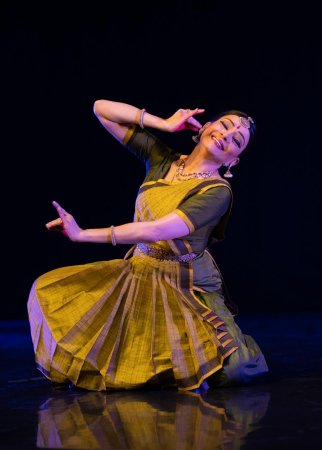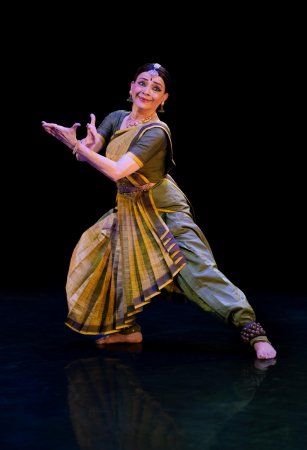
|   |

|   |
Malavika Sarukkai enchants the audience at the NCPA - Sumana Sachidananda e-mail: sumanas29@gmail.com Photos: Sudeep Bhattacharya May 15, 2025 Malavika Sarukkai, the doyenne of Bharatanatyam and the NCPA (The National Centre for the Performing Arts, Mumbai) go back a long way. She made her debut here in 1972, and she still reigns over the hearts of Mumbaikars who throng her shows with high expectations. She enthrals them every single time! Sarukkai presented 'Beeja - Earth Seed' at the massive Jamshed Bhabha Theatre, NCPA on the 27th of April as part of the Mudra Dance Festival. It was a full house, arguably unprecedented for a classical solo performance. Sarukkai is an enchantress to say the least. But she also manages to persuade the rasikas to ponder and introspect about burning issues. Through the medium of pure Bharatanatyam, she sparks conversations that are eye opening and engaging.  Malavika Sarukkai 'Beeja - Earth Seed' was a dance commentary on our planet earth, which is revered as Bhoomi Devi in our ancient culture. It spoke about the infinite potential of this seed, which has nurtured every organism with great care, but in return has been plundered and damaged to toxic levels. This unique production spoke of mother earth from the perspectives of subaltern voices such as the Tree, the Swan and the Deer. These loving and wise creatures narrate their experiences of life on this planet earth, reminiscing about the glorious past and expressing concern over the future. They urge humans to pause, reflect and acknowledge the grave misdeeds of their species that have destroyed their beautiful home - Planet Earth. The commentary as narrated by the Wise Banyan Tree, which itself was once a seed that held its ground was stirring and lyrical. This wise tree became the leitmotif / recurring central theme to the production, with the refrain of "I am the seed that held its ground" in the Tree poems. Creative collaborator, filmmaker and poet Sumantra Ghoshal's voice was a deep baritone bursting with emotion and gravitas. His poetry evoked complex human emotions and brought the production alive. Beeja opened with the sounds of the ancient chants on the Hiranya Garbha - The Golden Womb, the primordial source of creation of the universe. It is the cosmic seed in a sense and has limitless potential. With reverberating verses from the Rig Veda recited by scholar B.V. Sooryanarayanan and team, and brilliant sound design by Sai Shravanam, one felt immersed in the ever-expanding cosmos from the very start. Sarukkai likened Prithvi to the Hiranya Garbha since it is but a globe with endless possibilities, and depicted it as a tiny speck that can vanish in the blink of an eye. The Hiranya Garbha Sukta says, "Yasyēmāḥ pradiśō yasya bāhū" which means that the arms of this supreme entity – Hiranya Garbha - are the four directions / quarters of the universe. This was depicted beautifully by Sarukkai who simulated the imagery of the Dishas with arms extended fully as she glided across the stage in different directions. Life on Planet Earth is a mosaic of varied seasons and occurrences. Sarukkai segued into the exploration of seasons which kindle the deepest emotions in all living creations on earth. She delved further into the season of monsoon / Varsha, which is the favourite season of musicians and dancers alike. A season that is synonymous with longing, desire and exhilaration, there is no season like Varsha. Sarukkai chose verses from Kalidasa's Ritu Samhaara, which is an aesthetic tapestry of the 6 seasons of ancient India. She created stunning visuals of birds, elephants and other beings engaged in sweet love play as though mere puppets in the hands of the master puppeteer - the Rain God. What shone in this piece was her precise anga shuddhi which remains flawless till date. The thought, energy and sentiment behind every movement could permeate the mind of every rasika seated in the 1100 seater auditorium. A masterclass in stage deployment, movement vocabulary and presentation, it was a wonderful manifestation of Varsha, where one could experience 'petrichor' - the heady fragrance of wet earth. A particular shot of her getting drenched in the sensuality of Varsha to the soothing tune of raag Desh left an indelible image in the mind. You can capture the hearts of the rasikas even without jumping and stamping. Just the intensity of her movement and eyes that surrendered to the raindrops proved what a legend she is. This was followed by the perspective of the Swan / Hamsa which is known for its "Hamsa Ksheera Nyaaya" - the astounding ability and wisdom to discriminate milk from water. Sarukkai depicted the picturesque scene of a bevy of swans dancing in the moonlit lake, on a starry night. "Vishatavegam chandra tara keernam", meaning the cloud moving swiftly in the skies adorned with the moon and stars, indicate the ethereal ambiance of the moment. "Hamsaho sheera marjayatepiha" denotes a swan cleaning its wings and purifying itself. This piece ended with "Soham Hamsaha" which is the guiding expression of the Advaita philosophy which regards the jivatma and paramatma as inseparable. Sarukkai alluded to the swan being that perceptive, unblemished body that can redeem itself even in the midst of a polluted world. Not just the superficial pollution that destroys our beloved earth, but also spiritual contamination that is equally damaging to the soul. Sarukkai's dance has a meditative quality to it which is rare and uplifting. The next piece was the story of the Doe and her Fawn. The touching Tamil song (written by Sarukkai herself in English originally and translated into Tamil by Rajkumar Bharathi) says "Kuzhandai ilanutti ilammutti" implying the innocent abandon of childhood. The fawn prances around in glee and curiosity, unaware of the complexities of the world. Its guiding light, its mother the Doe takes it into the vast expanse of the jungle which abounds in hope and uncertainty in equal measure. The chemistry between the mother and child was heartwarming to watch. Armed with dexterous hands and agile limbs, Sarukkai leapt across the stage effortlessly. Her expressive eyes brought alive the joys and fears of the endearing fawn that is simply fascinated by the wildlife it witnesses. All was hunky-dory, scenic and blissful for the rasikas until this point in time, when we heard a deafening crashing of the tree to the ground. A rude shock! This plot twist propelled the production to the next level of storytelling.  Malavika Sarukkai Enter all the atrocities man has unleashed on Mother Earth; plunder of natural resources, inventions that wreck nature, utter disregard for fellow creatures such as trees, birds, animals, etc. and most of all, an insatiable greed. The Wise Old Banyan Tree laments the downfall of the human civilization, that was once in sync with nature. Today, it seems to be fixated on accumulating riches and power at the cost of this very core of its existence - Prakruti. Poet Sumantra Ghoshal's poignant lines - "I have watched chimneys belch smoke, On land where once my friends grazed. I have watched entire migrations erased. I have felt the very air choke", tugged at the heartstrings. The Tree that stands as a sentinel to the vagaries of human behaviour, asks the cruel human to introspect. It beseeches him to revisit history etched on its whorls, which is rife with stories of violent conquests that caused destruction of the natural eco-system. This composition had striking sound design by Sai Shravanam which transported us to the battleground. The martyrs of war are not just human soldiers, but also other living creatures and the elements of nature which die a slow death. And not just wars fought to mark territories... what about the smaller battles that nature has to face on a daily basis? The poor cow ingesting the plastic bag, the plants being injected with hormones / chemicals to bear more fruit, the industrial effluents flooding the rivers, the smuggling of endangered species, deforestation, the vehicular smoke that leaves one gasping for breath, the list is endless. How can man despite his intelligence, awareness and sagacity, stoop so low? Sarukkai assumed the form of the evil human unleashing damage in his world, with great vigour and potency. Her body language transformed so seamlessly; it was hard to believe it was the same dancer who had played the lovelorn bird earlier. Sarukkai's portrayal of the Wise Tree begging the human to rekindle his friendship with it was moving. With her delicate arms stretched out as the Shakhas / Pallavas of the Tree, and her torso the trunk, she became the Tree in all its glory. In Hinduism, there are several philosophical connotations to the Tree, especially the auspicious ones such as the Peepal, Banyan, Bilva and so on. Lord Krishna in the Bhagavad Gita has said that among trees he is the Banyan tree / Ashvattha tree. It is this tree that reigns like a king over thousands of years and provides shelter to all. The Wise Old Banyan Tree proved to be a befitting protagonist of sorts in this production, telling its story passionately. It was such a compelling embodiment of a Tree (or any being of nature), as rendered by Sarukkai. In the aftermath of the savage behaviour of man, there appears a blurry vision in the distance. It seems to be getting bigger and bigger every moment. The vocalist Krithika Aravind sang "Kannil theriyaradu oru thottram", indicating that the eyes seem to catch a glimpse of a big tree. Or wait a minute! Is it a mushroom cloud? The towering clouds of smoke that engulf the naïve and remind them of the consequences of transgression. Could anything be more devastating than a large-scale explosion, particularly nuclear as we have seen historically in Hiroshima and Nagasaki? When fire consumes all, the human succumbs too. Sarukkai's illustration of the unrelenting Agni as a flame of fire was striking and terrifying. Sarukkai implored the rasikas to think and question - do we want to see a loving, generous tree or a symbol of man's inner devil at the distance? Do we want to respect, nurture and cherish this Beeja - Earth Seed for giving us all that we have, or do we want to burn down its very essence? Can humans survive on earth bereft of her abundance, even for a minute? Shouldn't we learn from the wise ones - Tree, Swan and Deer - about maintaining peaceful coexistence? All of these very pertinent questions were raised by Sarukkai, in her crisp and impactful production. The closing scene brought us back to the very beginning. Suspended in the humongous cosmos is an effulgent dot, the Earth - our home. But blink, and it could be gone! A sharp and no-frills climax. Literally in the blink of an eye, one could see the bright Beeja - Earth Seed vanish into thin air. Kudos to the light designer Niranjan Gokhale, who delivered the closing shot with the required punch that stunned the audience. It made us all realise that indeed we could lose all that we have as a community, if we don't turn over a new leaf. Malavika Sarukkai has deliberately moved away from presenting traditional/ repertoire pieces and has chosen challenging themes for her productions such as Ganga - Nitya Vaahini, Vamatara - To the Light, Thari - The Loom, Anubandh - Connectedness, and The Battle Within. The reason she is such a superhit with audiences is that, while her storytelling is fresh and original, her grammar is as traditional as can be. Her nritta is sophisticated with perfect lines, sturdy araimandi, graceful curves and a rich vocabulary. Her abhinaya is truly evocative. Her sensational stage presence is testament to her surrender to Bharatanatyam. During the curtain call the audience gave her a standing ovation, and her collaborators / accompanists stood by her side with great pride to thank the rasikas. While all the music was composed and pre-recorded by veteran Rajkumar Bharati, Sarukkai had her mridangist Nellai Balaji and vocalist Krithika Aravind on either side of the stage, adding elements whenever required. The rich layers in the music that included the clever use of the cello, bawu, veena, sitar and tabla, elevated the performance significantly. The bespoke costume in lush, earthy hues was designed by Sandhya Raman, and the ghunghroos were crafted by Gangadharan. Take a bow, Malavika Sarukkai and team, for charming and educating over a 1000 discerning rasikas at the NCPA!  Sumana Sachidananda is a Kathak dancer based in Mumbai. She is an MBA from ISB Hyderabad and has also trained in Carnatic music. She holds a Senior Diploma in Kathak from Bharatiya Vidya Bhavan and is a DD graded artist. |